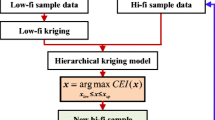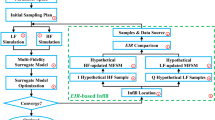Abstract
Multi-fidelity surrogate (MFS) method is very promising for the optimization of complex problems. The optimization capability of MFS can be improved by infilling samples in the optimization process. Furthermore, once the gradient information is provided, the gradient-enhanced kriging (GEK) can be utilized to construct a more accurate MFS model. However, for the existing infill sampling criterions, it is difficult to improve the optimization speed without sacrificing the optimization gains. In this paper, a novel infill sampling criterion named Adaptive Multi-fidelity Expected Improvement (AMEI) is proposed, in which the prediction accuracy and the optimization potential of the surrogate model are both considered. With a set of extra samples calculated, the AMEI determines which fidelity model for the new sample is to be added. Through two numerical examples and two engineering examples, it can be found that the AMEI always provides the best optimization result with the fewest analysis calls, and the robustness is also good. The optimization capability and efficiency of the AMEI have been demonstrated compared with traditional criterions.



















Similar content being viewed by others
References
Booker AJ, Dennis JJ, Frank PD, Serafini DB, Torczon V, Trosset MW (1999) A rigorous framework for optimization of expensive functions by surrogates. Struct Multidiscip Optim 17(1):1–13
Choi S, Alonso JJ, Kroo IM, Wintzer M (2004) Multi-fidelity design optimization of low-boom supersonic business jets. J Aircr 45(1):106–118
Chung HS, Alonso J (2002) Using gradients to construct cokriging approximation models for high-dimensional design optimization problems. In: 40th AIAA Aerospace Sciences Meeting & Exhibit. https://doi.org/10.2514/6.2002-317
Fischer CC, Grandhi RV (2013) Utilizing an adjustment factor to scale between multiple fidelities within a design process: a stepping stone to dialable fidelity design. In: 16th AIAA Non-Deterministic Approaches Conference. https://doi.org/10.2514/6.2014-1011
Fischer CC, Grandhi RV (2015) A surrogate-based adjustment factor approach to multi-fidelity design optimization. In: 17th AIAA Non-Deterministic Approaches Conference. https://doi.org/10.2514/6.2015-1375
Forrester AI, Keane AJ (2009) Recent advances in surrogate-based optimization. J Prog Aerosp Sci 45(1–3):50–79
Frazier PI, Powell WB, Dayanik S (2008) A knowledge-gradient policy for sequential information collection. SIAM J Control Optim 47(5):2410–2439
Gano SE, Renaud JE, Sanders B (2004) Variable fidelity optimization using a kriging based scaling function. In: 10th AIAA/ISSMO Multidisciplinary Analysis and Optimization Conference. https://doi.org/10.2514/6.2004-4460
Giselle Fernández-Godino M, Park C, Kim NH, Haftka RT (2019) Issues in deciding whether to use multifidelity surrogates. AIAA J 57. https://doi.org/10.2514/1.J057750
Guo Z, Song L, Park C, Li J, Haftka RT (2018) Analysis of dataset selection for multi-fidelity surrogates for a turbine problem. Struct Multidiscip Optim 57(6):2127–2142
Haftka RT (1991) Combining global and local approximations. AIAA J 29(9):1523–1525
Haftka RT, Villanueva D, Chaudhuri A (2016) Parallel surrogate-assisted global optimization with expensive functions–a survey. Struct Multidiscip Optim 54(1):3–13
Han ZH, Zhang KS (2012) Surrogate-based optimization. InTech Book:343–362
Han ZH, Zimmerman R, Görtz S (2012) Alternative cokriging method for variable-fidelity surrogate modeling. AIAA J 50(5):1205–1210
Han ZH, Görtz S, Zimmermann R (2013) Improving variable-fidelity surrogate modeling via gradient-enhanced kriging and a generalized hybrid bridge function. Aerosp Sci Technol 25:177–189
Hao P, Wang B, Li G (2012) Surrogate-based optimum design for stiffened shells with adaptive sampling. AIAA J 50(11):2389–2407
Hao P, Yuan XJ, Liu HL, Wang B, Liu C, Yang DX, Zhan SX (2017a) Isogeometric buckling analysis of composite variable-stiffness panels. Compos Struct 165:192–208
Hao P, Wang YT, Liu XX, Wang B, Li G (2017b) An efficient adaptive-loop method for non-probabilistic reliability-based design optimization. Comput Method Appl M 324:689–711
Hao P, Wang YT, Liu C, Wang B, Wu H (2017c) A novel non-probabilistic reliability-based design optimization algorithm using enhanced chaos control method. Comput Method Appl M 318:572–593
Hao P, Yuan XJ, Liu C, Liu HL, Wang B, Li G, Niu F (2018a) An integrated framework of exact modeling, isogeometric analysis and optimization for variable-stiffness composite panels. Comput Method Appl M 339:205–238
Hao P, Feng SJ, Zhang K, Li Z, Wang B, Li G (2018b) Adaptive gradient-enhanced kriging model for variable-stiffness composite panels using isogeometric analysis. Struct Multidiscip Optim 58(1):1–16
Hao P, Wang YT, Ma R, Liu H, Wang B, Li G (2019) A new reliability-based design optimization framework using isogeometric analysis. Comput Method Appl M 345:476–501
Havens D, Shiyekar S, Norris A, Bird RK, Kapania RK, Olliffe R (2011) Design, optimization, and evaluation of integrally stiffened Al-2139 panel with curved stiffeners. NASA/TP–2011-217178
Huang D, Allen TT, Notz WI (2006a) Global optimization of stochastic black-box systems via sequential kriging meta-models. J Glob Optim 34(3):441–466
Huang D, Allen TT, Notz WI, Miller RA (2006b) Sequential kriging optimization using multiple-fidelity evaluations. Struct Multidiscip Optim 32(5):369–382
Huang G, Wang H, Li G (2016) An efficient reanalysis assisted optimization for variable-stiffness composite design by using path functions. Compos Struct 153:409–420
Jones DR, Schonlau M, Welch WJ (1998) Efficient global optimization of expensive black-box functions. J Glob Optim 13(4):455–492
Kennedy MC, O'Hagan A (2000) Predicting the output from a complex computer code when fast approximations are available. Biometrika 87(1):1–13
Li Z, Ruan SL, Gu JF, Wang XY, Shen CY (2016) Investigation on parallel algorithms in efficient global optimization based on multiple points infill criterion and domain decomposition. Struct Multidiscip Optim 54(4):747–773
Liu J, Hang ZH, Song WP (2012) Comparison of infill sampling criteria in kriging-based aerodynamic optimization. P 28 C Int Counc Aer
Liu Y, Chen S, Wang F, Xiong F (2018) Sequential optimization using multi-level cokriging and extended expected improvement criterion. Struct Multidiscip Optim 7:1–19
Mcfarland J, Mahadevan S, Romero V, Swiler L (2015) Calibration and uncertainty analysis for computer simulations with multivariate output. AIAA J 46(5):1253–1265
Mehmani A, Chowdhury S, Messac A (2015) Predictive quantification of surrogate model fidelity based on modal variations with sample density. Struct Multidiscip Optim 52(2):353–373
Park C, Haftka RT, Kim NH (2017) Remarks on multi-fidelity surrogates. Struct Multidiscip Optim 55:1029–1050
Poloczek M, Wang J, Frazier P (2017) Multi-information source optimization. Adv Neural Inform Pr:4288–4298
Qian PZG, Wu CFJ (2008) Bayesian hierarchical modeling for integrating low-accuracy and high-accuracy experiments. Technometrics 50(2):192–204
Queipo NV, Haftka RT, Shyy W, Goel T, Vaidyanathan R, Tucker PK (2005) Surrogate-based analysis and optimization. Prog Aerosp Sci 41(1):1–28
Rehman SU, Langelaar M, Keulen FV (2014) Efficient kriging-based robust optimization of unconstrained problems. J Comput Sci 5(6):872–881
Sasena MJ, Papalambros P, Goovaerts P (2002) Exploration of metamodeling sampling criteria for constrained global optimization. Eng Optim 34(3):263–278
Sóbester A, Leary SJ, Keane AJ (2005) On the design of optimization strategies based on global response surface approximation models. J Glob Optim 33(1):31–59
Song XG, Lv LY, Sun W, Zhang J (2019) A radial basis function-based multi-fidelity surrogate model: exploring correlation between high-fidelity and low-fidelity models. Struct Multidiscip Optim:1–17
Ulaganathan S, Couckuyt I, Ferranti F (2015) Performance study of multi-fidelity gradient enhanced kriging. Struct Multidiscip Optim 51(5):1017–1033
Viana FAC, Haftka RT, Steffen V (2009) Multiple surrogates: how cross-validation errors can help us to obtain the best predictor. Struct Multidiscip Optim 39(4):439–457
Wang H, Li G (2012) Min–median–max metamodel-based unconstrained nonlinear optimization problems. Struct Multidiscip Optim 45(3):401–415
Wang B, Tian K, Hao P, Cai YW, Li YW, Sun Y (2015) Hybrid analysis and optimization of hierarchical stiffened plates based on asymptotic homogenization method. Compos Struct 132:136–147
Wu D, Long T, Li YL, Jiang ML, Wang H, Huang B (2012) Aero-structure coupled optimization of high aspect ratio wing using enhanced adaptive response surface method. In: 14th AIAA ISSMO MULT A
Yamazaki W, Mavriplis DJ (2013) Derivative-enhanced variable fidelity surrogate modeling for aerodynamic functions. AIAA J 51(1):126–137
Yamazaki W, Rumpfkeil MP, Mavriplis DJ (2010) Design optimization utilizing gradient/hessian enhanced surrogate model. In: 28th AIAA Applied Aerodynamics Conference. Doi: 10.2514/6.2010-4363
Zhang Y, Han ZH, Zhang KS (2018) Variable-fidelity expected improvement method for efficient global optimization of expensive functions. Struct Multidiscip Optim 58(4):1431–1451
Zheng J, Shao X, Gao L, Jiang P, Li Z (2013a) A hybrid variable-fidelity global approximation modelling method combining tuned radial basis function base and kriging correction. J Eng Design 24(8):604–622
Zheng L, Hedrick TL, Mittal R (2013b) A multi-fidelity modelling approach for evaluation and optimization of wing stroke aerodynamics in flapping flight. J Fluid Mech 721(4):118–154
Zhu JH, Guo WJ, Zhang WH, Liu T (2017) Integrated layout and topology optimization design of multi-frame and multi-component fuselage structure systems. Struct Multidiscip Optim 56(1):21–45
Funding
This work was supported by the National Natural Science Foundation of China (11772078 and 11372062), the Young Elite Scientists Sponsorship Program by CAST (2017QNRC001), and the Project supported by Liaoning Provincial Natural Science Foundation (2019-YQ-01).
Author information
Authors and Affiliations
Corresponding authors
Ethics declarations
Conflict of interest
The authors declare that they have no conflict of interest.
Additional information
Responsible Editor: Raphael Haftka
Replication of results
The GEK model is improved from traditional kriging model, where the Lophaven’s Matlab Kriging toolbox of DACE is employed. The appendix provides the Matlab codes used to generate the results.
Publisher’s note
Springer Nature remains neutral with regard to jurisdictional claims in published maps and institutional affiliations.
Appendix Matlab code for the AMEI
Appendix Matlab code for the AMEI
%This part provides the codes of Hartmann 6 function in Section 3.2.2
%The parameters and the functions can be adjusted for other problems.
clear clc
dim=6;%dimension of this problem
mxn=50;%maximum iteration
t0=1*ones(1,dim);tl=0.00001*ones(1,dim);tu=20*ones(1,dim);%sets for GEK
Etol=0.0001;% the convergence condition
S1=lhsdesign(10,dim);%initial samples of low-fidelity model
S2=lhsdesign(5,dim);%initial samples of high-fidelity model
mt=lhsdesign(6,dim);%extra samples
xl=zeros(1,dim);xu=ones(1,dim);%lower and upper limitations of variables
n=size(mt,1);
global part y yc yt dmodel_low dmodel_Deta row
for i=1:size(S2,1)
[Asort,index]=sort(sum((S1-S2(i,:)).^2,2));
S1(index(1),:)=[];
end
S1=unique([S1;S2],'rows');
[y,yy]=fun_H(S2);%analysis code of high-fidelity model,y is response value, yy is the gradient information
[yc,yyc]=fun_L(S1);%analysis code of low-fidelity model
detay=max(y)-min(y);
infor=0;
Y1=[yc;yyc];Y2=[y;yy];
yh_t=fun_H(mt);yl_t=fun_L(mt);
for loop=1:mxn
[dmodel_low, ~] = dacefit(S1, Y1, @regpoly0,@corrgauss,t0,tl,tu);
[ty,~]= predictor(S2,dmodel_low);
[yt,yyt]=fun_L(S2);
[row,fval]=fmincon(@REG_FG,0.9,[],[],[],[],0.8,1.2);
d=y-row*yt;
dd=yy-row*yyt;
[dmodel_Deta, ~] = dacefit(S2,[d;dd],@regpoly0,@corrgauss,t0,tl,tu);
yL= predictor(mt,dmodel_low);
yD= predictor(mt,dmodel_Deta);
De=yh_t-row*yl_t;
rmse_RL=sqrt(1/n*sum((row*yL-yh_t).^2))/abs(mean(yh_t));
rmse_Deta=sqrt(sum((yD-De).^2)/n)/abs(mean(De));
part=1;
[news2,infor2]=ga(@AMEI,dim,[],[],[],[], xl,xu);
if -infor2>0.1*detay && rmse_RL<2*rmse_Deta && rmse_RL>rmse_Deta
infor=infor2;
[nyc,nyyc]=fun_L(news2);
S1=[S1;news2];yc=[yc;nyc];yyc=[yyc;nyyc];
Y1=[yc;yyc];
else
part=2;[news,infor]=ga(@AMEI,dim,[],[],[],[],xl,xu);
[nyc,nyyc]=fun_L(news);
S1=[S1;news];yc=[yc;nyc];yyc=[yyc;nyyc];
Y1=[yc;yyc];
[ny,nyy]=fun_H(news);
S2=[S2;news];y=[y;ny];yy=[yy;nyy];
Y2=[y;yy];
if -infor<Etol
break
end
end
end
function fun=REG_FG(row)
global yt y
fun=sqrt(sum((row*yt-y).^2));
end
function amei=AMEI(x)
global part y yc dmodel_low dmodel_Deta row
[n,~]=size(x);
[y1,s1]=predictor(x,dmodel_low);
[y2,s2]=predictor(x,dmodel_Deta);
if part==1 %update with AMEIL criterion
Ymin=min(yc); s=sqrt(s1);
Y=repmat(Ymin,n,1)-y1;
else %update with AMEIH criterion
Ymin=min(y); s=sqrt(row.^2.*s1+s2);
Y=repmat(Ymin,n,1)-y2-row.*y1;
end
id=find(s>0);
if isempty(id)==0
u=Y(id)./s(id);
PHI=normcdf(u,0,1);
phi=normpdf(u,0,1);
amei(id)=Y(id).*PHI+s(id).*phi;
end
id=find(s==0);
if isempty(id)==0
e=Y(id);
e(e<0)=0;
amei(id)=e;
end
amei=-amei;
end
function [y,dy]=fun_H(S)
for i=1:size(S,1)
x=S(i,:);
A=[10,3,17,3.5,1.7,8;0.05,10,17,0.1,8,14;3,3.5,1.7,10,17,8;17,8,0.05,10,0.1,14];
P=10^(-4)*[1312,1696,5569,124,8283,5886;2329,4135,8307,3736,1004,9991;
2348,1451,3522,2883,3047,6650;4047,8828,8732,5743,1091,381];
a=[1;1.2;3;3.2];
b=(repmat(x,4,[])'-P');
B=b.^2;
y(i,1)=1/(-1.94)*(2.58+a'*exp(-sum(A.*B',2)));
dy(1+(i-1)*size(S,2):i*size(S,2),1)=-1/1.94*(-2*a'.*A'.*b*exp(-sum(A.*B',2)));
end
end
function [y,dy]=fun_L(S)
for i=1:size(S,1)
x=S(i,:);
A=[10,3,17,3.5,1.7,8;0.05,10,17,0.1,8,14;3,3.5,1.7,10,17,8;17,8,0.05,10,0.1,14];
P=10^(-4)*[1312,1696,5569,124,8283,5886;2329,4135,8307,3736,1004,9991;
2348,1451,3522,2883,3047,6650;4047,8828,8732,5743,1091,381];
a=[0.5;0.5;2;4];
b=(repmat(x,4,[])'-P');
B=b.^2;
fv=(exp(-4/9)+exp(-4/9)*((-sum(A.*B',2)) +4)/9 );
y(i,1)=-1/1.94*(2.58+a'*(exp(-4/9)+exp(-4/9)*((-sum(A.*B',2)) +4)/9 ).^9);
dy(1+(i-1)*size(S,2):i*size(S,2),1)=2/1.94*A'.*b*(a.*fv.^8)*exp(-4/9);
end
end
Rights and permissions
About this article
Cite this article
Hao, P., Feng, S., Li, Y. et al. Adaptive infill sampling criterion for multi-fidelity gradient-enhanced kriging model. Struct Multidisc Optim 62, 353–373 (2020). https://doi.org/10.1007/s00158-020-02493-8
Received:
Revised:
Accepted:
Published:
Issue Date:
DOI: https://doi.org/10.1007/s00158-020-02493-8




